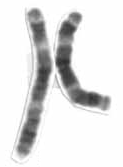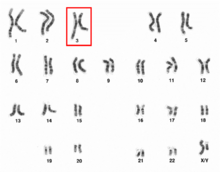

| Chromosome 3 | |
|---|---|

Human chromosome 3 pair after G-banding. One is from mother, one is from father.
| |

Chromosome 3 pair
in human male karyogram. | |
| Features | |
| Length (bp) | 201,105,948 bp (CHM13) |
| No. of genes | 1,024 (CCDS)[1] |
| Type | Autosome |
| Centromere position | Metacentric[2] (90.9 Mbp[3]) |
| Complete gene lists | |
| CCDS | Gene list |
| HGNC | Gene list |
| UniProt | Gene list |
| NCBI | Gene list |
| External map viewers | |
| Ensembl | Chromosome 3 |
| Entrez | Chromosome 3 |
| NCBI | Chromosome 3 |
| UCSC | Chromosome 3 |
| Full DNA sequences | |
| RefSeq | NC_000003 (FASTA) |
| GenBank | CM000665 (FASTA) |
Chromosome 3 is one of the 23 pairs of chromosomesinhumans. People normally have two copies of this chromosome. Chromosome 3 spans 201 million base pairs (the building material of DNA) and represents about 6.5 percent of the total DNA in cells.
The following are some of the gene count estimates of human chromosome 3. Because researchers use different approaches to genome annotation their predictions of the number of genes on each chromosome varies (for technical details, see gene prediction). Among various projects, the collaborative consensus coding sequence project (CCDS) takes an extremely conservative strategy. So CCDS's gene number prediction represents a lower bound on the total number of human protein-coding genes.[4]
| Estimated by | Protein-coding genes | Non-coding RNA genes | Pseudogenes | Source | Release date |
|---|---|---|---|---|---|
| CCDS | 1,024 | — | — | [1] | 2016-09-08 |
| HGNC | 1,036 | 483 | 761 | [5] | 2017-05-12 |
| Ensembl | 1,073 | 1,158 | 761 | [6] | 2017-03-29 |
| UniProt | 1,081 | — | — | [7] | 2018-02-28 |
| NCBI | 1,085 | 1,108 | 902 | [8][9][10] | 2017-05-19 |
The following is a partial list of genes on human chromosome 3. For complete list, see the link in the infobox on the right.
Partial list of the genes located on p-arm (short arm) of human chromosome 3:
Partial list of the genes located on q-arm (long arm) of human chromosome 3:
The following diseases and disorders are some of those related to genes on chromosome 3:
| Chr. | Arm[18] | Band[19] | ISCN start[20] |
ISCN stop[20] |
Basepair start |
Basepair stop |
Stain[21] | Density |
|---|---|---|---|---|---|---|---|---|
| 3 | p | 26.3 | 0 | 175 | 1 | 2,800,000 | gpos | 50 |
| 3 | p | 26.2 | 175 | 263 | 2,800,001 | 4,000,000 | gneg | |
| 3 | p | 26.1 | 263 | 408 | 4,000,001 | 8,100,000 | gpos | 50 |
| 3 | p | 25.3 | 408 | 642 | 8,100,001 | 11,600,000 | gneg | |
| 3 | p | 25.2 | 642 | 759 | 11,600,001 | 13,200,000 | gpos | 25 |
| 3 | p | 25.1 | 759 | 963 | 13,200,001 | 16,300,000 | gneg | |
| 3 | p | 24.3 | 963 | 1269 | 16,300,001 | 23,800,000 | gpos | 100 |
| 3 | p | 24.2 | 1269 | 1357 | 23,800,001 | 26,300,000 | gneg | |
| 3 | p | 24.1 | 1357 | 1561 | 26,300,001 | 30,800,000 | gpos | 75 |
| 3 | p | 23 | 1561 | 1751 | 30,800,001 | 32,000,000 | gneg | |
| 3 | p | 22.3 | 1751 | 1926 | 32,000,001 | 36,400,000 | gpos | 50 |
| 3 | p | 22.2 | 1926 | 2013 | 36,400,001 | 39,300,000 | gneg | |
| 3 | p | 22.1 | 2013 | 2188 | 39,300,001 | 43,600,000 | gpos | 75 |
| 3 | p | 21.33 | 2188 | 2451 | 43,600,001 | 44,100,000 | gneg | |
| 3 | p | 21.32 | 2451 | 2626 | 44,100,001 | 44,200,000 | gpos | 50 |
| 3 | p | 21.31 | 2626 | 3239 | 44,200,001 | 50,600,000 | gneg | |
| 3 | p | 21.2 | 3239 | 3385 | 50,600,001 | 52,300,000 | gpos | 25 |
| 3 | p | 21.1 | 3385 | 3676 | 52,300,001 | 54,400,000 | gneg | |
| 3 | p | 14.3 | 3676 | 3910 | 54,400,001 | 58,600,000 | gpos | 50 |
| 3 | p | 14.2 | 3910 | 4143 | 58,600,001 | 63,800,000 | gneg | |
| 3 | p | 14.1 | 4143 | 4362 | 63,800,001 | 69,700,000 | gpos | 50 |
| 3 | p | 13 | 4362 | 4566 | 69,700,001 | 74,100,000 | gneg | |
| 3 | p | 12.3 | 4566 | 4814 | 74,100,001 | 79,800,000 | gpos | 75 |
| 3 | p | 12.2 | 4814 | 4946 | 79,800,001 | 83,500,000 | gneg | |
| 3 | p | 12.1 | 4946 | 5077 | 83,500,001 | 87,100,000 | gpos | 75 |
| 3 | p | 11.2 | 5077 | 5135 | 87,100,001 | 87,800,000 | gneg | |
| 3 | p | 11.1 | 5135 | 5266 | 87,800,001 | 90,900,000 | acen | |
| 3 | q | 11.1 | 5266 | 5427 | 90,900,001 | 94,000,000 | acen | |
| 3 | q | 11.2 | 5427 | 5602 | 94,000,001 | 98,600,000 | gvar | |
| 3 | q | 12.1 | 5602 | 5762 | 98,600,001 | 100,300,000 | gneg | |
| 3 | q | 12.2 | 5762 | 5850 | 100,300,001 | 101,200,000 | gpos | 25 |
| 3 | q | 12.3 | 5850 | 5996 | 101,200,001 | 103,100,000 | gneg | |
| 3 | q | 13.11 | 5996 | 6229 | 103,100,001 | 106,500,000 | gpos | 75 |
| 3 | q | 13.12 | 6229 | 6361 | 106,500,001 | 108,200,000 | gneg | |
| 3 | q | 13.13 | 6361 | 6594 | 108,200,001 | 111,600,000 | gpos | 50 |
| 3 | q | 13.2 | 6594 | 6682 | 111,600,001 | 113,700,000 | gneg | |
| 3 | q | 13.31 | 6682 | 6871 | 113,700,001 | 117,600,000 | gpos | 75 |
| 3 | q | 13.32 | 6871 | 6973 | 117,600,001 | 119,300,000 | gneg | |
| 3 | q | 13.33 | 6973 | 7148 | 119,300,001 | 122,200,000 | gpos | 75 |
| 3 | q | 21.1 | 7148 | 7294 | 122,200,001 | 124,100,000 | gneg | |
| 3 | q | 21.2 | 7294 | 7440 | 124,100,001 | 126,100,000 | gpos | 25 |
| 3 | q | 21.3 | 7440 | 7674 | 126,100,001 | 129,500,000 | gneg | |
| 3 | q | 22.1 | 7674 | 7936 | 129,500,001 | 134,000,000 | gpos | 25 |
| 3 | q | 22.2 | 7936 | 8053 | 134,000,001 | 136,000,000 | gneg | |
| 3 | q | 22.3 | 8053 | 8228 | 136,000,001 | 139,000,000 | gpos | 25 |
| 3 | q | 23 | 8228 | 8461 | 139,000,001 | 143,100,000 | gneg | |
| 3 | q | 24 | 8461 | 8811 | 143,100,001 | 149,200,000 | gpos | 100 |
| 3 | q | 25.1 | 8811 | 9001 | 149,200,001 | 152,300,000 | gneg | |
| 3 | q | 25.2 | 9001 | 9162 | 152,300,001 | 155,300,000 | gpos | 50 |
| 3 | q | 25.31 | 9162 | 9264 | 155,300,001 | 157,300,000 | gneg | |
| 3 | q | 25.32 | 9264 | 9366 | 157,300,001 | 159,300,000 | gpos | 50 |
| 3 | q | 25.33 | 9366 | 9453 | 159,300,001 | 161,000,000 | gneg | |
| 3 | q | 26.1 | 9453 | 9803 | 161,000,001 | 167,900,000 | gpos | 100 |
| 3 | q | 26.2 | 9803 | 9949 | 167,900,001 | 171,200,000 | gneg | |
| 3 | q | 26.31 | 9949 | 10183 | 171,200,001 | 176,000,000 | gpos | 75 |
| 3 | q | 26.32 | 10183 | 10329 | 176,000,001 | 179,300,000 | gneg | |
| 3 | q | 26.33 | 10329 | 10489 | 179,300,001 | 183,000,000 | gpos | 75 |
| 3 | q | 27.1 | 10489 | 10620 | 183,000,001 | 184,800,000 | gneg | |
| 3 | q | 27.2 | 10620 | 10737 | 184,800,001 | 186,300,000 | gpos | 25 |
| 3 | q | 27.3 | 10737 | 10883 | 186,300,001 | 188,200,000 | gneg | |
| 3 | q | 28 | 10883 | 11175 | 188,200,001 | 192,600,000 | gpos | 75 |
| 3 | q | 29 | 11175 | 11700 | 192,600,001 | 198,295,559 | gneg |
{{cite journal}}: CS1 maint: numeric names: authors list (link)
|
| |||||
|---|---|---|---|---|---|
| Nuclear genome |
| ||||
| Mitochondrial genome | |||||
| Related topics |
| ||||
|
| |||||
|---|---|---|---|---|---|
| Basic concepts |
| ||||
| Types |
| ||||
| Processes and evolution |
| ||||
| Structures |
| ||||
| See also |
| ||||